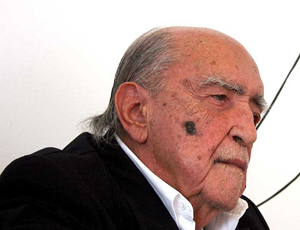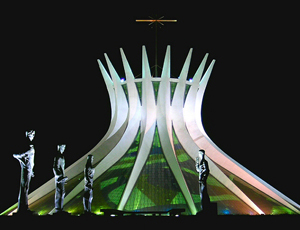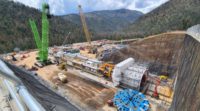

The idea of moving Brazil's capital to the undeveloped interior dated to 1789, but it took until 1957 for work to begin. Brazilian architect Oscar Niemeyer, along with his mentor, Lucio Costa, created a ''revolutionary'' jet-plane design, with the city's main axis, federal offices and distinctive Cathedral Metropolitana as the ''fuselage'' and its embassies and residences as the ''wings.''
Niemayer, whose design was initially disdained by the government workers who would populate the new city and others, eventually became one of the world’s signature architects. In his home country, he was held in statesman-like reverence.
Just 10 days from celebrating his 105th birthday, Niemeyer died in Rio de Janeiro on Dec. 5. The cause was a respiratory infection, according to O Empreiteiro, a national construction industry publication.
In a statement, Brazil President Dilma Rousseff called Niemeyer "a revolutionary, the mentor of a new architecture, beautiful, logical, and, as he himself defined it, inventive."
Sergio Magalhaes, president of the Brazilian Institute of Architects, added: "Beyond being an architect, Niemeyer was a man ahead of his time who stood in solidarity with the people and who was loved as few have been."
Volume of Works
O Empreiteiro Editor-in-Chief Nildo Carlos Oliveira points to Niemeyer’s “valuable legacy in terms of his creativity, the volume of works he designed and … the ethical integrity of his character. He will be immortalized in his works.”
Oliveira notes the strong collaboration between Niemeyer and Brazil’s engineering and construction community in bringing his unorthodox designs to practical reality.
"It is not the right angle that attracts me," Niemeyer said in his memoirs, according to one Brazilian newspaper. "What attracts me is the free and sensual curve.” He observed such curves “in the mountains of my country … in the winding course of the senses … in the clouds of heaven, in the body of the woman preferred.”
Such curves were “beyond the imagination here in Brazil and in other nations,” says Oliveira. “Each one of Niemeyer’s works ended up being an aesthetic surprise.”
Beside his well-known design of structures in Brasilia, such as the Alvorada Palace and the Cathedral of Brasilia, he also was noted for buildings at the University of Constantine in Algeria, a corporate complex in Milan and part of the United Nations headquarters in New York City. Niemeyer, an avowed communist, was in exile from Brazil from 1964 until the 1980s.
“No building is done by itself. No project Niemeyer created would stand up if it could not rely on engineering’s technical capacity,” says Oliveira. He adds that a Niemeyer design "did not use technical resources by chance. It was triggered and even challenged" to do so.
Collaboration of 'Genial' Engineers
The O Empreiteiro editor says, “Because engineers believed in their [own] possibilities before [Neimeyer’s] daring stand, engineering was able to build monuments." Oliveira adds, "When Brasilia was built, Niemeyer relied on the collaboration of 'genial' engineers."
Oliveira notes one Brasilia government building "whose 60-meter-diameter, inverted dome softly lands on the slab." He says engineer Joaquim Cardozo "worked long hours ... finding the proper curve to solve the 'landing' of the inverted dome on the slab."
For his design of the University of Constantine, Neimeyer imported Brazilian engineers to Algeria to calculate a beam so that it would not be "more than 1.5 meters thick," Oliveira says.
"Foreign engineers who were making the calculations refused to admit that such an important beam for the building could be built so thin," Oliveira notes. Niemeyer knew the Brazilians would "calculate the beam as specified," he says.
Niemeyer was awarded architecture’s noted Pritzker Prize in 1988 and the Royal Institute of British Architects' Royal Gold Medal in 1998.
In 1999, ENR named Brasilia one of the world's Top 125 Projects of the past 125 years for the year 1960, when it was completed.
But according to one published Brazilian account, in response to the accolades, he said, "I worked hard and did my job on the drawing board as an ordinary man."





Post a comment to this article
Report Abusive Comment